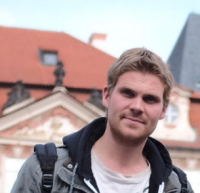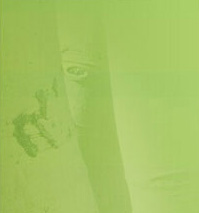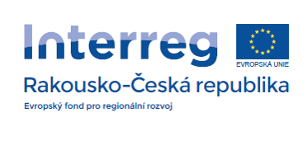 ^^^
^^^
Daniel Bonhenry, Ph.D.
Position

Zámek 136, CZ 373 33 Nové Hrady
Phone: +420 389 033 822
bonhenry@nh.cas.cz
Past Projects
Education
2010–2013 - Ph.D. Thesis - University of Lorraine, Nancy, France
Thesis: Vectorization of therapeutic peptides across biological membranes
Description: This work explored the evolution of the protonation state of a titrable peptides as a fonction of its position inside phospholipid bilayers.
Advisors: Dr. Mounir Tarek & Dr. Francois Dehez
2008–2010 M.Sc University of Franche-Comte, Besancon, France
Cum laude · Speciality: Molecular interactions and material physics
Master thesis: Inclusion and stability of a gramicidin protein inside carbon nanotubes: Synthesis of a biomimetic membrane (2 publications, see publications record attached)
Advisors: Prof. Christophe Ramseyer & Assoc. Prof. Fabien Picaud
2005–2008 - B.Sc University of Franche-Comte, Besancon, France
Speciality: Graduated in Physics and Chemistry
Specialization in theoretical physics and scientific programmation (Fortran + Maple)
Work experience
Jan. 2017 – present - Post-doctoral position
Center for Nanobiology and Structural Biology, Nové Hrady
Study of the pereation of calcium ions through a calcium released activated channel by molecular dynamics simulation.
Apr. 2014 – Dec. 2016 - Post-doctoral position
Institute of Organic Chemistry and Biochemistry,Prague
Molecular dynamic simulations of Green Fluorescent proteins (native and mutants) attached to a phospholipidic membrane. Activation/deactivation of the voltage-sensitive domain from the cis-phosphatase (including wild-type and mutants).
Oct. 2010 – Oct. 2013 - Post-doctoral position
SRSMC Nancy
Research Assistant, University - CNRS — Nancy
Molecular dynamics simulations and free-energy calculations related to the tranfer of molecule across bio-membranes. Electroporation studies and electric field effects upon the transfer of cell penetrating peptide with a cargo molecule.
Jan–Jun 2010 Research Assistant, Universty - CNRS Besancon, UTINAM
Computer simulations of nanoparticles in interaction with proteins.2
Jan–Jun 2009 Research Assistant, Universty - CNRS — Besancon, UTINAM
Rate constants and cross sections computation.
computer skills
Basic C++, Adobe Illustrator, Abode Photoshop, Blender, Inkscape
Intermediate matlab, maple, LATEX, GIMP, OpenOffice
Advanced python, Fortran77, Tcl & bash scripting
Software NAMD, Gromacs, VMD, Plumed2
other information
Teaching service 2011 - 2013 · Science popularization
Scientific consultant during science fair and expositions for the general public and students (high school level). Assisted the organization committee.
Communication Skills
2016 · Poster presentation, Biomembranes days, Berlin, Germany.
2016 · Poster presentation, Biophysical society meeting, Los Angeles, California, USA.
2015 · Poster presentation, European biophysical society meeting, Dresden, Germany.
2013 · Seminar, SRSMC institute, Nancy, France.
2013 · Poster presentation, French chemical society meeting, Reims, France.
2013 · Chairman during a congress for PhD students helded by the french chemical society, Nancy, France.
2012 · Oral presentation, French chemical society meeting, Dijon, France.
2011 · Poster presentation, MOLSIM 2011 (CECAM), Amsterdam, Netherlands.
Languages
French · Mothertongue
English · Full professional proficiency (writing, speaking, reading)
German · Intermediate, B1 level
Czech · Basic, Learning
publications
2 M. Josef, D. Bonhenry, S. Timr and P. Jungwirth. Transmembrane potential modeling: Comparison between methods of constant electric field and ion imbalance. J. Chem. Theory Comput., 2016, 12(5) 2418 @ S2425.
3 F. Salomone, I. Leray, F. Cardarelli, C. Boccardi, D. Bonhenry, M. Tarek, L. Mir and F. Beltram. Selective endosomal vesicles electroporation by CM18-Tat11 peptide and nanosecond electric pulses cell co-administration. Mol. Pharmaceutics, 2014, 11 (7) : 2466 @ S2474.
4 M. Casciola, D. Bonhenry, M. Liberti, F. Apollonio and M. Tarek. Cholesterol rich lipid membranes electroporation : A molecular dynamics simulation study. Biochemistry, 2014, doi: 10.1016/j.bioelechem.2014.03.0093
5 D. Bonhenry, M. Tarek and F. Dehez. Effects of phospholipid composition on the transfer of a small cationic peptide across a model biological membrane. J. Chem. Theory Comput., 2013, 9(12) : 5675 @ S5684.
6 A. Polak, D. Bonhenry, F. Dehez, P. Kramar, D. Miklavčič and M. Tarek. On the electroporation thresholds of lipid bilayers : Molecular dynamics simulation investigations. J. Membr. Biol., 2012, 246(11): 843 @ S850.
7 D. Bonhenry, S. Kraszewski, F. Picaud, C. Ramseyer, S. Balme, J.-M. Janot and F. Henn. Stability of the gramicidin-a channel structure in view of nanofiltration : A computational and experimental study. Soft Matter, 2011, 7(22) :10651 @ S10659.
8 S. Balme, J.-M Janot, L. Berardo, F. Henn, D. Bonhenry, S. Kraszewski, P. Fabien and C. Ramseyer. New bioinspired membrane made of a biological ion channel confined into the cylindrical nanopore of a solid-state polymer. Nano Lett., 2011, 11(2) :712 @ S716.
Institute publications in impacted journals
- Daniel Bonhenry, Romana Schober, Tony Schmidt, Linda Waldherr, Rüdiger H Ettrich, Rainer Schindl (2019) Mechanistic insights into the Orai channel by molecular dynamics simulations. In: SEMINARS IN CELL & DEVELOPMENTAL BIOLOGY. Vol 94, pp. 50-58.
- Romana Schober, Daniel Bonhenry, Victoria Lunz, Jinhui Zhu, Adela Krizova, Irene Frischauf, Marc Fahrner, Meng Qi Zhang, Linda Waldherr, Tony Schmidt, Isabella Derler, Peter B. Stathopulos, Christoph Romanin, Rudiger H. Ettrich, Rainer Schindl (2019) Sequential activation of STIM1 links Ca2+ with luminal domain unfolding. In: Science Signaling. Vol 12, pp. eaax-3194.
- Irene Frischauf, Monika Litviňuková, Romana Schober, Vasilina Zayats, Barbora Svobodová, Daniel Bonhenry, Victoria Lunz, Sabrina Cappello, Laura Tociu, David Reha, Amrutha Stallinger, Anna Hochreiter, Teresa Pammer, Carmen Butorac, Martin Muik, Klaus Groschner, Ivan Bogeski, Rüdiger H Ettrich, Christoph Romanin, Rainer Schindl (2017) Transmembrane helix connectivity in Orai1 controls two gates for calcium-dependent transcription.. In: Science signaling. Vol 10, pp. 507-.



